Home > About Us > Sustainability Management > Sustainability Report > Sustainability Report 2015 > Measures Against Global Warming
 Measures Against Global Warming
Measures Against Global Warming
In response to global warming, the Kobe Steel Group promotes rationalization and R&D geared toward reducing energy consumption throughout its operations, while reducing greenhouse gas emissions.
Energy Conservation during Manufacturing Processes
![]()
In fiscal 2014, the Kobe Steel Group used 221PJ of energy (equivalent to 5.71 million kl of crude oil).
Of that total, approximately 95 percent was used in the Iron & Steel Business, and approximately 4 percent in Aluminum & Copper.
Kobe Steel continuously strives to reduce energy consumption through such methods as improvements to productivity and fuel management, the introduction of highly efficient equipment, and the recovery of waste heat.
Energy Usage by Business Unit (includes Group companies)
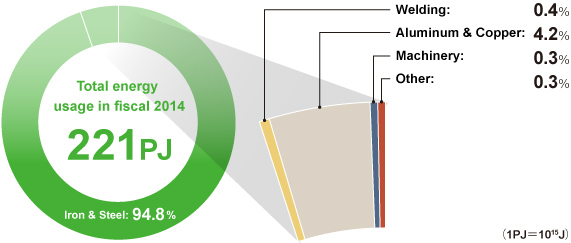
Iron & Steel Business (Kobe Steel)
![]()
In fiscal 2014, energy use and CO2 emissions in the Iron & Steel Business increased by 0.1 percent year-on-year. Compared to the base year (1990), the energy consumption rate per ton of crude steel improved by 15.6 percent, while CO2 emissions improved by 2.3 percent and the CO2 emissions rate improved by 14.3 percent.
Kakogawa Works finished construction of a second high-efficiency gas turbine for its private power station, which is now operating at high efficiency thanks to the two turbines.
Energy saving measures, such as the upgrading of exhaust heat recovery equipment and installation of air compressors, are also being implemented at other locations.
In the future, we will continue to implement energy conservation measures and reduce environmental impact, striving to achieve industry targets described in Nippon Keidanren’s Commitment to a Low Carbon Society.
Iron & Steel Business (Kobe Steel)
Energy Consumption/Energy Consumption Rate Index (Preliminary Calculations)
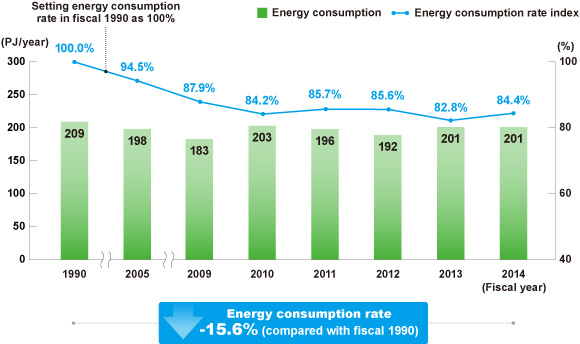
Iron & Steel Business (Kobe Steel)
CO2 Emissions/CO2 Emissions Rate Index (Preliminary Calculations)
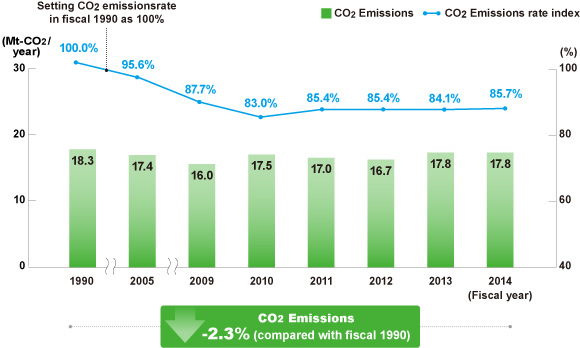
* Preliminary calculations for Iron & Steel Business totals include coke production. As emission factors from purchased power in fiscal 2014 have yet to be announced, results for fiscal 2013 were used.
Welding Business (Kobe Steel)
![]()
Through efforts to reduce loss, such as improvements to productivity and optimization of equipment, the Welding Business aims to reduce CO2 emissions. In fiscal 2014 we pursued improvements at the Fukuchiyama Plant, such as the introduction of inverters in production equipment.
CO2 emissions for fiscal 2014 were reduced by 28.2 percent in comparison to 1990, and the CO2 emission rate per ton of product was reduced by 25.6 percent.
Welding Business (Kobe Steel)
CO2 Emissions/CO2 Emissions Rate Index (Preliminary Calculations)
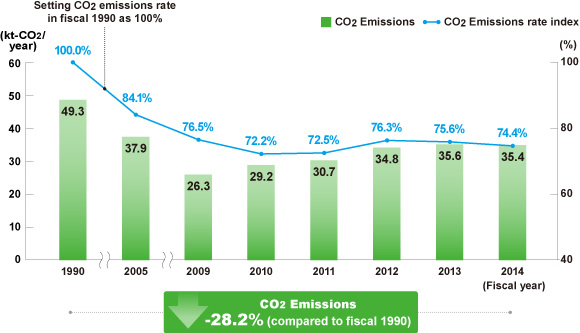
* In 2011, Kobe Welding Wire Co., Ltd. became Kobe Steel’s Fukuchiyama Plant and is therefore calculated together.
Aluminum & Copper Business (Kobe Steel)
![]()
The Aluminum & Copper Business has been switching from oil-based fuels to natural gas, as well as pursuing equipment intensification and efficiency. In fiscal 2014, fans for the hot-rolling stage and inverters for pumps were installed at the Moka Plant
CO2 emissions in fiscal 2014 were reduced by 35.2 percent in comparison to fiscal 1995, and the energy consumption rate was reduced by 12.8 percent.
Aluminum & Copper Business (Kobe Steel)
CO2 Emissions/Energy Consumption Rate Index (Preliminary Calculations)
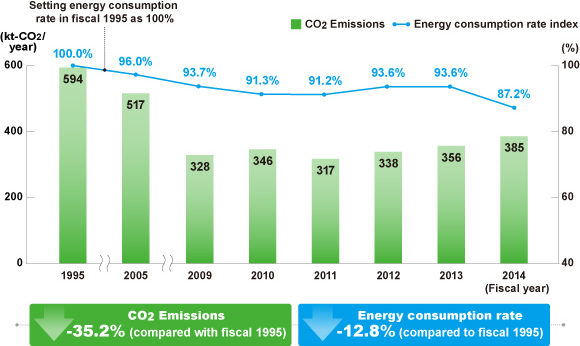
Machinery Business (Kobe Steel)
![]()
As demand for products such as energy-saving compressors, heat pumps and heavy-wall pressure vessels for the oil refining sector increases, the Machinery Business is also striving to increase energy efficiency through optimization of equipment and improvements to productivity.
CO2 emissions in fiscal 2014 increased by 6.3 percent compared with fiscal 1997, while the CO2 emission rate improved by 22 percent.
Machinery Business (Kobe Steel)
CO2 Emissions/CO2 Emissions Rate Index (Preliminary Calculations)
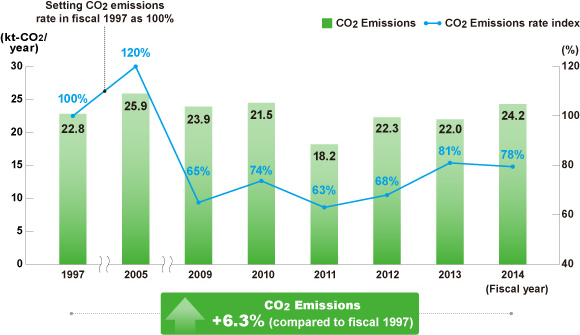
Initiatives at Kakogawa Works
![]()
Commercial Operation of Second Gas Turbine Combined Cycle Power Plant
![]()
-
A second gas turbine combined cycle (or GTCC) system was installed at Kakogawa Works. Construction finished in late 2014 and the plant has now entered commercial operation.
In order to overhaul the private power plant’s aging boilers we began sequential dismantling of the Works’ five gas-fired and one coal-fired boiler in 2009, replacing them with two boilers (gas-fired) and two GTCC systems.
The renovation reduces costs by increasing power generation efficiency and is expected to decrease CO2 emissions by 410,000 tons per year due to the elimination of the coal-fired boiler.
GTCC systems are highly efficient and contribute greatly to lower costs and reduced energy consumption and CO2. During initial planning, we expected that the blast furnace gas used as the base fuel for the turbines would require the addition of other gases with a higher calorific value, such as coke oven gas or LPG. In light of the Works’ overall energy balance we had planned to install only a single GTCC system. However, due to improvements in the combustion equipment, combustion control and monitoring technology, stable operation of the GTCC system became possible even when using fuel of a lower calorific value. As a result, we amended the plan and decided to install a second GTCC system.
Going forward, we will continue to pursue initiatives to improve energy efficiency and otherwise lower environmental impact.
-
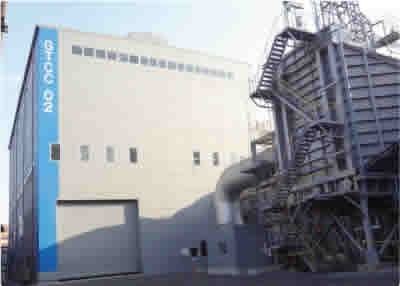
Exterior of the second GTCC power plant, which recently went into operation
Energy Conservation in the Logistics Field
![]()
From raw materials procurement to product delivery, the Kobe Steel Group aims to conserve energy through the use of optimized and speedy transportation. Ongoing improvements include expanding modal shifts from the use of trucks to the use of rail and ships; increasing loading efficiency; improving transportation efficiency through larger vehicles; and expanding use of roundtrip shipping.
We have also been working to improve fuel efficiency, such as through introduction of cutting-edge steel transport ships and lighter weight shipping vehicles.
Group Company Initiatives
![]()
Individual Kobe Steel Group companies also strive to reduce energy during manufacturing processes and distribution. In addition to the initiatives mentioned below, Group companies also implement a wide array of daily measures to conserve energy, such as turning off lights and regulating air-conditioning.
Examples of Initiatives
| Company name | Location | Example of initiatives |
|---|---|---|
| Ceratechno Co., Ltd. | Bizen, Okayama Prefecture | Utilization of waste heat at the drying furnace cooling zone, installation of invertors for vacuum pumps, etc. |
| Tesac Wirerope Co., Ltd. | Kaizuka, Osaka Prefecture | Energy conservation through boiler upgrades |
| Japan Aeroforge, Ltd. | Kurashiki, Okayama Prefecture | Introduction of Top Runner transformers and unit number control for hydraulic circuits |
| Kobe Special Tube Co., Ltd. | Shimonoseki, Yamaguchi Prefecture | Introduction of ceramic radiators for heating equipment |
| Shinko-North Co., Ltd. | Kasumigaura, Ibaraki Prefecture | Reduced energy consumption through transformer upgrades |
| Shinko Fab Tech, Ltd. | Shimonoseki, Yamaguchi Prefecture | Optimized operation through energy visualization, temperature diagnosis of large furnaces, upgrades to high-efficiency transformers |
| Shinko Metal Products Co., Ltd. | Kitakyushu, Fukuoka Prefecture | Energy conservation through preheating furnace refractory upgrades, reduced heat loss through changes to temperature control methods |
| Shinko Engineering Co., Ltd. | Ogaki, Gifu Prefecture | Improved yield rate through use of casting simulation software, improved operating ratio through use of carburizing simulation software, etc. |
| Kobelco Research Institute, Inc. | Amagasaki, Hyogo Prefecture | Energy conservation through adjustments to hydraulic settings, reduced air conditioning energy consumption through use of insulating materials |
| Kobelco Construction Machinery Co., Ltd. | Hiroshima, Hiroshima Prefecture | Energy conservation through use of central monitoring systems, switching factory lighting to LEDs |
| Kobelco Eco-Solutions Co., Ltd. | Kako-gun, Hyogo Prefecture | Energy conservation through combustion adjustment of furnace |
| Shinko Industrial Co., Ltd. | Kurayoshi, Tottori Prefecture | Use of hot water from annealing furnace* waste heat |
| Japan Superconductor Technology, Inc. | Kobe, Hyogo Prefecture | Changes to air conditioning temperature settings, turning off ceiling mercury lamps during breaks, green curtains (bitter melon cultivation), etc. |
| Twin Foods Co., Ltd. | Ichikawa, Chiba Prefecture | Switched to LED lighting, introduction of invertors for freezer fans |
| Kobe Special Steel Wire Products (Pinghu) Co., Ltd. | Pinghu, Zhejiang Province, China | Switching to LED lighting |
| Kobelco Spring Wire (Foshan) Co., Ltd. | Foshan, Guangdong Province, China | Energy-saving design for factory building (ceiling daylighting, summer heat measures), energy conservation during heat treatment and through concentrated production, etc. |
| Kobelco Welding Asia Pacific Pte. Ltd. | Singapore | Introduction of high-efficiency lighting |
* Annealing furnace: Heat treatment furnace used to improve material characteristics.


